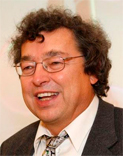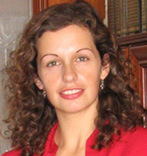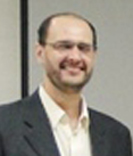
SEMINAR
The Workshop on Renewable Energy Sources and Nanotechnology
WREN 2017

SEMINAR 2: Formation of H2 from H2O Using Advanced Photoelectrosynthetic Systems–Physical boundary conditions and material science challenges
Speaker: W. Jaegermann
Abstract: One of the most demanding research aims for an holistic and sustainable energy economy is the integration of storage devices to solar energy converters to overcome the discontinuous supply of solar power. The direct production and use of chemical fuels would provide a favourable solution. However, inherent problems in the direct production of H2 from solar light has not been solved yet in a satisfying way.
Direct H2 formation by photo electrosynthetic H2O splitting theoretically provides high light (photon) to fuel (H2) efficiency. Advanced materials and design concepts based on the coupling of wide band gap semiconductors i.e. ZnTe, GaP, SiC or thin film Si or 3-5 tandem (multijunction) cells and nano sized metal catalysts are considered as very promising options. Alternatively band gap modified and defect engineered nanosized oxides are considered as alternatives to meet the requirements. Materials and devices of this type must be designed, grown, processed and characterized combining the demands of a photovoltaic converter coupled loss free to an efficient electrolyser component.
From a consideration of the given thermodynamic and kinetic conditions to split H2O we expect that only tandem (multijunction) structures with a sufficient splitting of the quasi-Fermi level equivalent to the provided photovoltage of the solar converter component will be able to split H2O into H2 (HER) and O2 (OER. As a consequence the first duty is to optimize the light converting devices structure in a similar way as it has to be done for electric power producing solar cells. This means that the transport lengths of charge carriers must exceed the thickness of the device, where the thickness of the absorber layer has to exceed the absorption length for planar systems. Subsequently the separated charge carriers must be transferred to the surface reaction sites without loss in chemical potentials (photovoltage) and loss in photocurrent. In the case of multi electron transfer reactions catalysed by metallic particles the interactions of intermediates of the HER and OER with the electro catalyst’s surfaces must be taken into account. For minimizing loss mechanism the position of the band edges, metal Fermi level, and electrolyte density of states must be arranged in a proper way. We suggest that only buried junction devices will be able to fulfil these conditions.
We will present and discuss our research approach on photo electrochemical water splitting devices giving a survey on most interesting systems from our point of view. The materials science issues, which are needed to overcome often given limitations of H2O splitting devices will be discussed and results of recent experimental investigations to verify our concepts will be presented. In collaboration with FZ Jülich triple thin film Si solar cells have been developed which has reached 9.5 % solar to H2 efficiency. For particular systems Janus type heterostructure particles of novel oxides with closed electron shells have been investigated as promising alternatives. These devices are clearly defined examples of promising design concepts of future further improved fuel producing solar converter cells.

SEMINAR 3: Tuning CO2 electroreduction selectivity through rational catalyst and electrolyte designa.
Speaker: Beatriz Roldan Cuenya
Abstract: Tailoring the chemical reactivity of nanomaterials at the atomic level is one of the most important challenges in electro-catalysis research. In order to achieve this elusive goal, we must first obtain a fundamental understanding of the structural and chemical properties of these complex systems. In addition, the dynamic nature of the nanostructured films and nanoparticle (NP) catalysts and their response to the electrochemical environment must be taken into consideration, since their working state might not be the state in which the catalyst was prepared, but rather a structural and/or chemical isomer that adapted to the particular reaction conditions. To address the complexity of real-world electrocatalysts, a synergistic approach taking advantage of a variety of cutting-edge experimental methods (EC-AFM, XPS, XAFS) has been undertaken here.
This talk will focus on model nanostructured thin film and NP electrocatalysts (Ag, Zn, Cu, and Cu-M with M = Au, Co, Zn, Au) for the electrocatalytic reduction of CO2. We will show how to tune catalytic selectivity based on rational catalyst and electrolyte design involving controlling the NP size, shape and interparticle distance as well as the electrolyte properties by adding cations and anions (Cs+, Li+, Na+, K+, I-, Br-, Cl-). We will provide insight into structure/chemical state/composition-reactivity correlations during the electrochemical reduction of CO2 through an in situ and operando approach under reaction conditions. The results are expected to open up new routes for the reutilization of CO2 through its direct selective conversion into valuable chemicals and fuels such as carbon monoxide, methane, ethylene, ethanol, and propanol.

SEMINAR 4: Wind energy - current status and future prospects.
Speaker: Javier Serrano González
Abstract: Wind energy is one of most mature renewable energy technologies. Overall installed capacity in the world has achieved 432 GW (63 GW of new installations during 2015), being a key technology for a future de-carbonized generation mix. In Brazil, installed wind energy capacity overtook the 8 GW mark during 2015, being the 4th country in the world by new installations during that year (with 2.7 GW, just behind China, Germany and USA). This work intends to provide an overview of the most important aspects involved in the future development of new wind energy facilities. Not only from a technological point of view, but also analyzing other crucial aspects such as resource availability, market status, grid integration/development and regulatory framework (comprising feed-in tariffs, connection procedure and local market content requirements). First, it will be focused on wind technology: basic principles, current status of technology, future developments (mainly based on the current research activities promoted by the European R&D programmes) and grid integration. After, it will cover the other above-mentioned non-technological aspects with special attention to the current status of the key aspects which led to the current success of the Brazilian wind energy market, which is one of the most successful markets in terms of both new capacity installations, capacity factors and cost of wind energy.

SEMINAR 5: : Fundamental Aspects and Applications of Nanotechnology.
Speaker: Jordan Del Nero
Abstract: This presentation concerns on push-pull devices. At this stage of the research it seems to be possible to separate molecular electronic devices in four general branches: (a) Donorbet-π bridge-Acceptorbet; (b) Donor- σ bridge-Acceptor (presented here); (c) Donorbet- σ bridge-Acceptorbet, and (d) Donor-π bridge-Acceptor (Donorbet and Acceptorbet means donor and acceptor of betaine type). We simulate charge accumulation and depletion in the donor group as a function of an external voltage applied in the nanostructure backbone. By our results general rules were point out: (i) the rectification occurs for saturable bonds independent of the backbone size (beyond of previous ab initio predictions); (ii) the I - V curves obtained by Hartree-Fock and Landauer-Büttiker calculations give us information about transport properties, presenting a simple picture in terms of a ballistic resonant model; (iii) Also, under specific conditions these systems could be used as a bi-directional FET with two operation regions, in direct/reverse bias.
Sponsorship
Realization
Support








WREN 2017. © All Right Reserved


